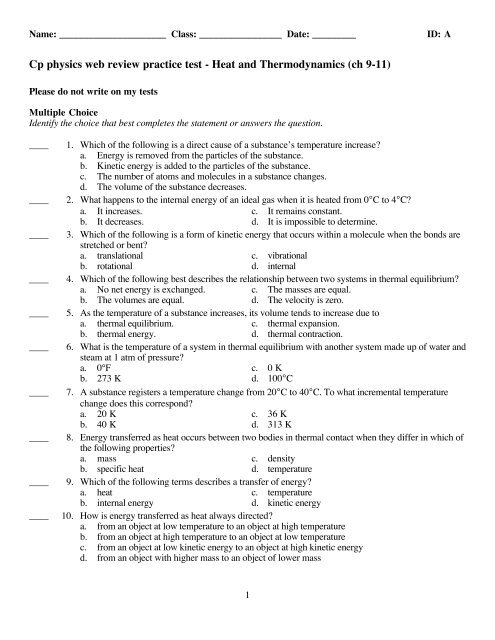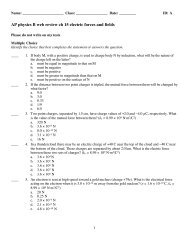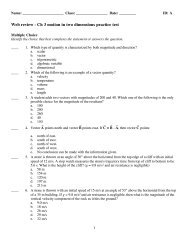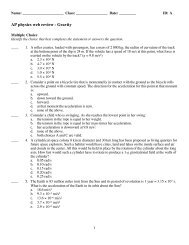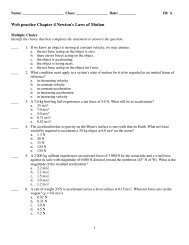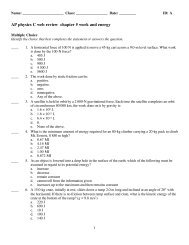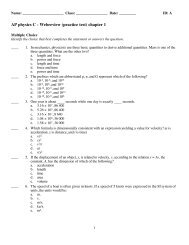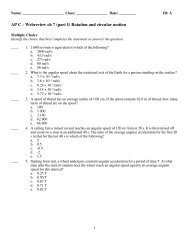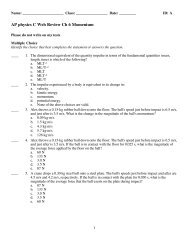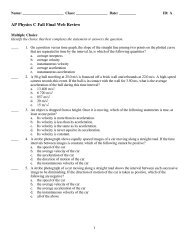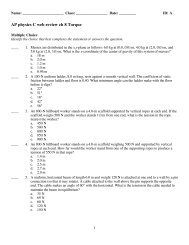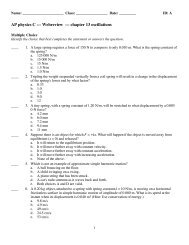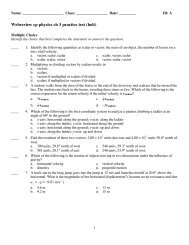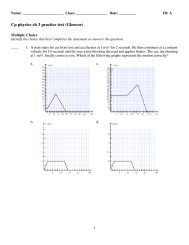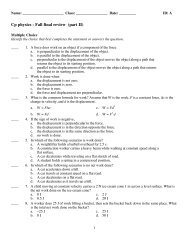Cp physics web review practice test - Heat and Thermodynamics (ch 9-11)
Cp physics web review practice test - Heat and ... - Planet Holloway
Cp physics web review practice test - Heat and ... - Planet Holloway
- No tags were found...
You also want an ePaper? Increase the reach of your titles
YUMPU automatically turns print PDFs into web optimized ePapers that Google loves.
Name: ______________________ Class: _________________ Date: _________<br />
ID: A<br />
<strong>Cp</strong> <strong>physics</strong> <strong>web</strong> <strong>review</strong> <strong>practice</strong> <strong>test</strong> - <strong>Heat</strong> <strong>and</strong> <strong>Thermodynamics</strong> (<strong>ch</strong> 9-<strong>11</strong>)<br />
Please do not write on my <strong>test</strong>s<br />
Multiple Choice<br />
Identify the <strong>ch</strong>oice that best completes the statement or answers the question.<br />
____<br />
____<br />
____<br />
____<br />
____<br />
____<br />
____<br />
____<br />
____<br />
____<br />
1. Whi<strong>ch</strong> of the following is a direct cause of a substance’s temperature increase?<br />
a. Energy is removed from the particles of the substance.<br />
b. Kinetic energy is added to the particles of the substance.<br />
c. The number of atoms <strong>and</strong> molecules in a substance <strong>ch</strong>anges.<br />
d. The volume of the substance decreases.<br />
2. What happens to the internal energy of an ideal gas when it is heated from 0°C to 4°C?<br />
a. It increases. c. It remains constant.<br />
b. It decreases. d. It is impossible to determine.<br />
3. Whi<strong>ch</strong> of the following is a form of kinetic energy that occurs within a molecule when the bonds are<br />
stret<strong>ch</strong>ed or bent?<br />
a. translational c. vibrational<br />
b. rotational d. internal<br />
4. Whi<strong>ch</strong> of the following best describes the relationship between two systems in thermal equilibrium?<br />
a. No net energy is ex<strong>ch</strong>anged. c. The masses are equal.<br />
b. The volumes are equal. d. The velocity is zero.<br />
5. As the temperature of a substance increases, its volume tends to increase due to<br />
a. thermal equilibrium. c. thermal expansion.<br />
b. thermal energy. d. thermal contraction.<br />
6. What is the temperature of a system in thermal equilibrium with another system made up of water <strong>and</strong><br />
steam at 1 atm of pressure?<br />
a. 0°F c. 0 K<br />
b. 273 K d. 100°C<br />
7. A substance registers a temperature <strong>ch</strong>ange from 20°C to 40°C. To what incremental temperature<br />
<strong>ch</strong>ange does this correspond?<br />
a. 20 K c. 36 K<br />
b. 40 K d. 313 K<br />
8. Energy transferred as heat occurs between two bodies in thermal contact when they differ in whi<strong>ch</strong> of<br />
the following properties?<br />
a. mass c. density<br />
b. specific heat d. temperature<br />
9. Whi<strong>ch</strong> of the following terms describes a transfer of energy?<br />
a. heat c. temperature<br />
b. internal energy d. kinetic energy<br />
10. How is energy transferred as heat always directed?<br />
a. from an object at low temperature to an object at high temperature<br />
b. from an object at high temperature to an object at low temperature<br />
c. from an object at low kinetic energy to an object at high kinetic energy<br />
d. from an object with higher mass to an object of lower mass<br />
1
Name: ______________________<br />
ID: A<br />
____<br />
____<br />
____<br />
<strong>11</strong>. If energy is transferred from a table to a block of ice moving across the table, whi<strong>ch</strong> of the following<br />
statements is true?<br />
a. The table <strong>and</strong> the ice are at thermal equilibrium.<br />
b. The ice is cooler than the table.<br />
c. The ice is no longer 0°C.<br />
d. Energy is being transferred from the ice to the table.<br />
12. What three properties of a substance affect the amount of energy transferred as heat to or from the<br />
substance?<br />
a. volume, temperature <strong>ch</strong>ange, specific heat capacity<br />
b. density, temperature <strong>ch</strong>ange, specific heat capacity<br />
c. mass, temperature <strong>ch</strong>ange, specific heat capacity<br />
d. mass, temperature <strong>ch</strong>ange, latent heat<br />
13. Whi<strong>ch</strong> of the following is true during a phase <strong>ch</strong>ange?<br />
a. Temperature increases. c. Temperature decreases.<br />
b. Temperature remains constant. d. There is no transfer of energy as heat.<br />
____<br />
____<br />
14. The figure above shows how the temperature of 10.0 g of ice <strong>ch</strong>anges as energy is added. Whi<strong>ch</strong> of<br />
the following statements is correct?<br />
a. The water absorbed energy continuously, but the temperature increased only when<br />
all of the water was in one phase.<br />
b. The water absorbed energy sporadically, <strong>and</strong> the temperature increased only when<br />
all of the water was in one phase.<br />
c. The water absorbed energy continuously, <strong>and</strong> the temperature increased<br />
continuously.<br />
d. The water did not absorb energy.<br />
15. At what point on the figure above does the substance undergo a phase <strong>ch</strong>ange?<br />
a. A c. C<br />
b. B d. E<br />
2
Name: ______________________<br />
ID: A<br />
____<br />
____<br />
____<br />
____<br />
____<br />
____<br />
____<br />
____<br />
____<br />
____<br />
____<br />
16. Using the figure above, determine whi<strong>ch</strong> value equals the latent heat required to <strong>ch</strong>ange the liquid<br />
water into steam.<br />
a. 8.04 × 10 3 J c. 30.6 × 10 3 J<br />
b. 22.6 × 10 3 J d. 31.1 × 10 3 J<br />
17. At what point on the figure above is the amount of energy transferred as heat approximately<br />
4.19 × 10 3 J?<br />
a. A c. C<br />
b. B d. D<br />
18. What accounts for an increase in the temperature of a gas that is kept at constant volume?<br />
a. Energy has been removed as heat from the gas.<br />
b. Energy has been added as heat to the gas.<br />
c. Energy has been removed as work done by the gas.<br />
d. Energy has been added as work done on the gas.<br />
19. When an ideal gas does positive work on its surroundings, whi<strong>ch</strong> of the gas’s quantities increases?<br />
a. temperature c. pressure<br />
b. volume d. internal energy<br />
20. An ideal gas system is maintained at a constant volume of 4 L. If the pressure is constant, how mu<strong>ch</strong><br />
work is done by the system?<br />
a. 0 J c. 8 J<br />
b. 5 J d. 30 J<br />
21. Air cools as it escapes from a diver’s compressed air tank. What kind of process is this?<br />
a. isovolumetric c. adiabatic<br />
b. isobaric d. isothermal<br />
22. What thermodynamic process for an ideal gas system has an un<strong>ch</strong>anging internal energy <strong>and</strong> a heat<br />
intake that corresponds to the value of the work done by the system?<br />
a. isovolumetric c. adiabatic<br />
b. isobaric d. isothermal<br />
23. Whi<strong>ch</strong> thermodynamic process takes place when work is done on or by the system but no energy is<br />
transferred to or from the system as heat?<br />
a. isovolumetric c. adiabatic<br />
b. isobaric d. isothermal<br />
24. Whi<strong>ch</strong> thermodynamic process takes place at a constant temperature so that the internal energy of a<br />
system remains un<strong>ch</strong>anged?<br />
a. isovolumetric c. adiabatic<br />
b. isobaric d. isothermal<br />
25. Whi<strong>ch</strong> thermodynamic process takes place at constant volume so that no work is done on or by the<br />
system?<br />
a. isovolumetric c. adiabatic<br />
b. isobaric d. isothermal<br />
26. In an isovolumetric process for an ideal gas, the system’s <strong>ch</strong>ange in the energy as heat is equivalent to<br />
a <strong>ch</strong>ange in whi<strong>ch</strong> of the following?<br />
a. temperature c. pressure<br />
b. volume d. internal energy<br />
3
Name: ______________________<br />
ID: A<br />
____<br />
____<br />
____<br />
____<br />
____<br />
27. During an isovolumetric process, whi<strong>ch</strong> of the following does not <strong>ch</strong>ange?<br />
a. temperature c. pressure<br />
b. volume d. internal energy<br />
28. How is conservation of internal energy expressed for a system during an adiabatic process?<br />
a. Q = W = 0, so ΔU = 0 <strong>and</strong> U i<br />
= U f<br />
b. Q = 0, so ΔU = –W<br />
c. ΔT = 0, so ΔU = 0; therefore, ΔU = Q – W = 0, or Q = W<br />
d. ΔV = 0, so PΔV = 0 <strong>and</strong> W = 0; therefore, ΔU = Q<br />
29. How is conservation of internal energy expressed for a system during an isovolumetric process?<br />
a. Q = W = 0, so ΔU = 0 <strong>and</strong> U i<br />
= U f<br />
b. Q = 0, so ΔU = –W<br />
c. ΔT = 0, so ΔU = 0; therefore, ΔU = Q – W = 0, or Q = W<br />
d. ΔV = 0, so PΔV = 0 <strong>and</strong> W = 0; therefore, ΔU = Q<br />
30. How is conservation of internal energy expressed for a system during an isothermal process?<br />
a. Q = W = 0, so ΔU = 0 <strong>and</strong> U i<br />
= U f<br />
b. Q = 0, so ΔU = –W<br />
c. ΔT = 0, so ΔU = 0; therefore, ΔU = Q – W = 0, or Q = W<br />
d. ΔV = 0, so PΔV = 0 <strong>and</strong> W = 0; therefore, ΔU = Q<br />
31. How is conservation of internal energy expressed for an isolated system?<br />
a. Q = W = 0, so ΔU = 0 <strong>and</strong> U i<br />
= U f<br />
b. Q = 0, so ΔU = –W<br />
c. ΔT = 0, so ΔU = 0; therefore, ΔU = Q – W = 0, or Q = W<br />
d. ΔV = 0, so PΔV = 0 <strong>and</strong> W = 0; therefore, ΔU = Q<br />
Short Answer<br />
32. The figure above shows how the temperature of 10.0 g of ice <strong>ch</strong>anges as energy is added. What<br />
happens to the ice at 0°C?<br />
4
Name: ______________________<br />
ID: A<br />
33. The figure above shows how the temperature of 10.0 g of ice <strong>ch</strong>anges as energy is added. What<br />
happens to the ice at 100°C?<br />
34. The figure above shows how the temperature of 10.0 g of ice <strong>ch</strong>anges as energy is added. What<br />
happens to the ice between 0°C <strong>and</strong> 100°C?<br />
Problem<br />
35. What temperature on the Celsius scale is the equivalent of 88.0°F?<br />
36. Liquid oxygen has a temperature of –183°C. What is this temperature in kelvins?<br />
37. A falling stone with a mass of 0.255 kg strikes the ground. Assuming that the stone is initially at rest<br />
when it begins falling, how high must the stone be above the ground for the internal energy of the<br />
stone <strong>and</strong> ground to increase by 2450 J? (g = 9.81 m/s 2 )<br />
38. What is the temperature increase of 4.0 kg of water when it is heated by an 8.0 × 10 2 W immersion<br />
heater for exactly 10.0 min? (cp = 4186 J/kg•°C)<br />
39. An electric drill bores through a 0.100 kg piece of copper in 30.0 s. Find the increase in the<br />
temperature of the copper if the drill operates at 40.0 W. Assume that the drill does not increase in<br />
temperature. (c p<br />
= 387 J/kg•°C)<br />
40. Find the final equilibrium temperature when 10.0 g of milk at 10.0°C is added to 1.60 × 10 2 g of<br />
coffee with a temperature of 90.0°C. Assume the specific heats of coffee <strong>and</strong> milk are the same as for<br />
water (c p, w<br />
= 4.19 J/g•°C), <strong>and</strong> disregard the heat capacity of the container.<br />
41. A container of gas is at a pressure of 3.7 × 10 5 Pa. How mu<strong>ch</strong> work is done by the gas if its volume<br />
exp<strong>and</strong>s by 1.6 m 3 ?<br />
42. A container of gas is at a pressure of 1.3 × 10 5 Pa <strong>and</strong> a volume of 6.0 m 3 . How mu<strong>ch</strong> work is done<br />
by the gas if it exp<strong>and</strong>s at constant pressure to twice its initial volume?<br />
43. A cylinder has a radius of 0.080 m. How mu<strong>ch</strong> work is done by a gas in the cylinder if the gas exerts<br />
a constant pressure of 7.8 × 10 5 Pa on the piston, moving it a distance of 0.060 m?<br />
44. A total of 165 J of work is done on a gaseous refrigerant as it undergoes compression. If the internal<br />
energy of the gas increases by 123 J during the process, what is the total amount of energy<br />
transferred as heat?<br />
45. The internal energy of a system is initially 63 J. A total of 71 J of energy is added to the system as<br />
heat while the system does 59 J of work. What is the system’s final internal energy?<br />
5
ID: A<br />
<strong>Cp</strong> <strong>physics</strong> <strong>web</strong> <strong>review</strong> <strong>practice</strong> <strong>test</strong> - <strong>Heat</strong> <strong>and</strong> <strong>Thermodynamics</strong> (<strong>ch</strong> 9-<strong>11</strong>)<br />
Answer Section<br />
MULTIPLE CHOICE<br />
1. B<br />
2. A<br />
3. C<br />
4. A<br />
5. C<br />
6. D<br />
7. A<br />
8. D<br />
9. A<br />
10. B<br />
<strong>11</strong>. B<br />
12. C<br />
13. B<br />
14. A<br />
15. B<br />
16. B<br />
17. C<br />
18. B<br />
19. B<br />
20. A<br />
21. C<br />
22. D<br />
23. C<br />
24. D<br />
25. A<br />
26. D<br />
27. B<br />
28. B<br />
29. D<br />
30. C<br />
31. A<br />
SHORT ANSWER<br />
32. The ice begins to melt <strong>and</strong> <strong>ch</strong>ange into water.<br />
33. The temperature stops rising, <strong>and</strong> the water turns into steam.<br />
34. The temperature of the melted ice (water) increases steadily until the water begins to vaporize at<br />
100°C.<br />
1
ID: A<br />
PROBLEM<br />
35. 31.1°C<br />
Given<br />
T F<br />
= 88.0°F<br />
Solution<br />
T F<br />
= 9 5 T C + 32.0<br />
T C<br />
= 5 (T − 32.0) = 5 (88.0 − 32.0)°C = 5 (56.0)°C = 31.1°C<br />
9 F 9 9<br />
36. 9.0 × 10 1 K<br />
Given<br />
T C<br />
= –183°C<br />
Solution<br />
T = T C<br />
+ 273.15<br />
T = (−183 + 273.15) K = 9.0 × 10 1 K<br />
37. 979 m<br />
Given<br />
m = 0.255 kg<br />
ΔU = 2450 J<br />
g = 9.81 m/s 2<br />
Solution<br />
ΔPE + ΔKE + ΔU = 0<br />
The kinetic energy increases with the decrease in potential energy, <strong>and</strong> then decreases with the<br />
increase in the internal energy of the water. Thus, the net <strong>ch</strong>ange in kinetic energy is zero.<br />
ΔPE + ΔU = 0<br />
Assuming final potential energy has a value of zero, the <strong>ch</strong>ange in the internal energy equals:<br />
0 − PE i<br />
+ ΔU = 0<br />
ΔU = PE i<br />
= mgh<br />
h = ΔU<br />
mg =<br />
2450 J<br />
(0.255 kg)(9.81 m/s 2 ) = 979 m<br />
2
ID: A<br />
38. 29°C<br />
Given<br />
m = 4.0 kg<br />
P = 8.0 × 10 2 W<br />
Δt = 10.0 min<br />
c p<br />
= 4186 J/kg°C<br />
Solution<br />
<strong>Heat</strong> equals the power delivered multiplied by the time interval.<br />
Q = PΔt<br />
Q = c p<br />
mΔT<br />
ΔT = PΔt<br />
c p<br />
m = (8.0 × 10 2 W)(10.0 min)<br />
×<br />
(4186 J/kg°C)(4.0 kg)<br />
39. 31.0°C<br />
Given<br />
m = 0.100 kg<br />
Δt = 30.0 s<br />
P = 40.0 W<br />
c p<br />
= 387 J/kg•°C<br />
Ê<br />
Ë<br />
Á<br />
60 s<br />
1 min<br />
ˆ<br />
¯<br />
˜ = 29°C<br />
Solution<br />
<strong>Heat</strong> equals the power delivered multiplied by the time interval.<br />
Q = PΔt<br />
Q = c p<br />
mΔT<br />
ΔT = PΔt<br />
c p<br />
m = (40.0 W)(30.0 s)<br />
(387 J/kg°C)(0.100 kg) = 31.0°C<br />
3
ID: A<br />
40. 85.3°C<br />
Given<br />
m m<br />
= 10.0 g<br />
T m<br />
= 10.0°C<br />
m c<br />
= 1.60 × 10 2 g<br />
T c<br />
= 90.0°C<br />
c p, w<br />
= 4.19 J/g•°C<br />
Solution<br />
From conservation of energy, the energy absorbed as heat by the milk equals the energy given up as<br />
heat by the coffee.<br />
Q m<br />
= −Q c<br />
c p, w<br />
m m<br />
ΔT m<br />
= −c p, w<br />
m c<br />
ΔT c<br />
c p, w<br />
m m<br />
(T f<br />
− T m<br />
) = −c p, w<br />
m c<br />
(T f<br />
− T c<br />
) = c p, w<br />
m c<br />
(T c<br />
− T f<br />
)<br />
m m<br />
T f<br />
+ m c<br />
T f<br />
= m c<br />
T c<br />
+ m m<br />
T m<br />
T f<br />
= m c T c + m m T m<br />
m m<br />
+ m c<br />
T f<br />
= (1.60 × 10 2 g)(90.0°C) + (10.0 g)(10.0°C)<br />
1.60 × 10 2 g + 10.0 g<br />
T f<br />
= 1.44 × 10 4 g°C + 1.00 × 10 2 g°C<br />
1.70 × 10 2 g<br />
T f<br />
= 1.45 × 10 4 g°C<br />
1.70 × 10 2 g<br />
= 85.3°C<br />
41. 5.9 × 10 5 J<br />
Given<br />
P = 3.7 × 10 5 Pa<br />
ΔV = 1.6 m 3<br />
Solution<br />
W = PΔV = (3.7 × 10 5 Pa)(1.6 m 3 ) = 5.9 × 10 5 J<br />
4
ID: A<br />
42. 7.8 × 10 5 J<br />
Given<br />
P = 1.3 × 10 5 Pa<br />
V i<br />
= 6.0 m 3<br />
V f<br />
= 2V i<br />
Solution<br />
W = PΔV<br />
ΔV = V f<br />
− V i<br />
= 2V i<br />
− V i<br />
= V i<br />
W = (1.3 × 10 5 Pa)(6.0 m 3 ) = 7.8 × 10 5 J<br />
43. 9.4 × 10 2 J<br />
Given<br />
r = 0.080 m<br />
P = 7.8 × 10 5 Pa<br />
d = 0.060 m<br />
Solution<br />
Work is done by the gas, so W is positive.<br />
W = PΔV = PAd<br />
A = πr 2<br />
W = PAd = Pπr 2 d = (7.8 × 10 5 Pa)(π)(0.080 m) 2 (0.060 m)<br />
P = 9.4 × 10 2 J<br />
44. –42 J, or 42 J transferred from the system as heat<br />
Given<br />
W = –165 J<br />
ΔU = 123 J<br />
Solution<br />
Work is done on the system, so W is negative.<br />
ΔU = Q − W<br />
Q = ΔU + W = 123 J + (–165 J) = − 42 J,or 42 J transferred from the system as heat<br />
5
ID: A<br />
45. 75 J<br />
Given<br />
U i<br />
= 63 J<br />
Q = 71 J<br />
W = 59 J<br />
Solution<br />
Work is done by the system, so W is positive. Energy is added as heat to the system, so Q is positive.<br />
ΔU = U f<br />
− U i<br />
= Q − W<br />
U f<br />
= U i<br />
+ Q − W = 63 J + 71 J − 59 J = 75 J<br />
6


